#Smart Manufacturing Market 2023
Explore tagged Tumblr posts
Text
Smart Manufacturing Market Outlook On The Basis Of Component, Technology, End-Use, Region And Forecast To 2030: Grand View Research Inc.
San Francisco, 21 Dec 2023: The Report Smart Manufacturing Market Size, Share & Trends Analysis Report By Component, By Technology (Product Lifecycle Management, 3D Printing, Enterprise Resource Planning), By End-use, By Region, And Segment Forecasts, 2023 – 2030 The global smart manufacturing market size is predicted to hit USD 787.54 billion by 2030, according to a new study by Grand View…

View On WordPress
#Smart Manufacturing Industry#Smart Manufacturing Market#Smart Manufacturing Market 2023#Smart Manufacturing Market 2030#Smart Manufacturing Market Revenue#Smart Manufacturing Market Share#Smart Manufacturing Market Size
0 notes
Text
#Robotics and job market impact#Automation and employment effects#Robotics and job displacement#Impact of robots on labor market#Robotics and future of work#Automation and job opportunitiesRobotics and career prospects#Robotics and career prospects#Impact of automation on workforce#Robotics and job security#Robotics and employment trends#Robotics 2023#Future of Robotics#"Robotics and AI 2023#Robotics Industry 2023#Smart Robotics 2023#Autonomous Robotics 2023#Robotics in manufacturing 2023#IoT and Robotics 2023#Robotics and automation 2023#Industry 4.0 and Robotics 2023
0 notes
Text

it's time for day two reveals! give these wonderful works some love, please!
01. wants and needs by matchesonlyburn
On a planet whose atmosphere is filled with a gas with... interesting side effects, Anakin and Obi-Wan are sent to take out a Separatist base. Fill for the Rough Sex square in the 2023 Obikin Bingo as well as a prompt claim for the Sub!Anakin Fest
02. bare grace misery by thedunesea
Anakin let out a pained sound. “I failed my men, I failed you, and now… and now this. Could you, Obi-Wan? Could you come from this humiliation?” His voice broke, and then he was weeping, hot tears streaming down his face even as he kept stroking himself, his sobs of shame intermingling with his whimpers of pleasure. The mixture was so unbelievably erotic Obi-Wan felt his head spin. Or: Anakin gets poisoned, and the antidote that saves his life has some uncomfortable side effects.
03. serenity, serenity by obikined
After learning that the Separatists have gained the favor of a weapons manufacturer that has the power to overturn the Clone Wars, a freshly knighted Anakin and Master Obi-Wan must infiltrate the organization's inner circle and eliminate the partnership at an exclusive event posed as black market dealers. The problem is, the two of them have to act as a married couple, Anakin assuming the role of coy, submissive husband to a domineering and firm handed Obi-Wan. Between Anakin's not-so-subtle pining, Obi-Wan's suppressed emotions, and the fate of the Republic on the line, the two of them must confront their messy feelings for one another over a game of high-stakes, winner takes all sabacc.
04. subakin and his obi-dom by stevewell0022
Anakin Skywalker was forever in denial. He could not admit, no sorry, would never accept he was a sub. No Never. He, the great and powerful Jedi Knight, was destined to be a dom, and he would not stop until his desires came to pass. Later that very same day?!!?? "Yes, Master. Thank you for allowing me to clean your boots, Master." Anakin Skywalker. Famed Jedi. Woefully and fecklessly in denial. It would take a gentle super-dom to bring Anakin to heel. Obi-Wan, the renowned selfless Jedi that he was, would of course volunteer for this heavy burden, and save the galaxy from a darker fate.
05. no fault of my own by denims
“You know you’re not supposed to like this,” Obi-Wan murmured, “and here you are, so wet for me and I’ve barely even touched you.” Anakin looked away, blinking back tears that threatened to well up in his eyes at his master’s disapproval, but he leaked more slick into his lap all the same. “I’m sorry, Master,” he quavered. “I can’t help it!”
06. en garde, prêt, allez by lemon (lemon_sprinkles)
Anakin Skywalker is a highly skilled fencer, known for his fast pace and brutal attack style. Young and arrogant, he carries himself as a man who knows he's going to win - no matter the cost. Obi-Wan Kenobi is an equally talented fencer who has more titles and championships attached to his name than most could ever dream of, and who has the respect and admiration from everyone in the community. When the two are paired off against each other during the World Championships, Anakin is caught between wanting to prove himself and win the title, and not dethroning a man who has inspired him both on and off the piste. They say never meet your heroes - and certainly never kick their ass in front of a stadium full of their peers - but winning on the piste might bring more treasures and rewards to Anakin than he ever thought possible.
07. who's loving you by demon_dean
Anakin Skywalker was the luckiest man alive. He had the relationship he had always desired. Well, almost.
08. untamed and full of teeth by deanswade
Obi-Wan felt something inside him break. It cracked and ruptured and rippled. He felt when the tongue met his skin, hot and dry. It didn't have enough strength to latch, but this boy, his boy, was smart. Obi-Wan shivered, as the boy lapped. So clever, so good, he drank until he couldn't anymore, stilling in Kenobi's hold before going lax. "Hold on for me, little one," Obi-Wan whispered, "Be brave. Don't let go." Or Obi-Wan is the owner of local high-end bar for vampires, when one night an unfortunate boy stumbles through his door, half-turned. Obi-Wan, who had never made a fledgling before, falls for Anakin hard and fast.
#subanakinfest#obikin#vaderwan#anakin skywalker#obi wan kenobi#obiani#anaobi#sub anakin fest#obikin event#obikin fics
61 notes
·
View notes
Text
Special Müller Mail: RDY edition
Hello everyone
and welcome to the Müller Mail Special.

FC Bayern's season is now officially over. Now the home European Championship is just around the corner and I can hardly wait to experience a great football festival in our country - as a player on the pitch, but also as a football fan.
We will be talking in detail about this major event in the coming weeks. In this special edition of Müller Mail, I would like to tell you about a project that I have put my heart and soul into.
After months of development work, RDY Protein Meal, the new protein drink meal that I launched together with ESN, is finally on the market. I was hooked from the very first idea, back in early 2023.
But first things first.

What is RDY?
We've all been there - a hectic everyday life, little time for a balanced meal, we're on the go and still want to eat smart.
This is exactly where the RDY drinkable meal comes into play for me.
RDY stands for "ready" and is a protein drinkable meal. Together with the experts at ESN, we have worked on a recipe that delivers the best possible performance and, in my opinion, is now the tastiest drinkable meal on the market.
RDY now contains 38g of high-quality protein, fiber, important vitamins and minerals. The energy/carbohydrates come from valuable MCT oil, among other things. And what makes me particularly happy is that all four flavors taste really nice.

Why RDY?
My basic idea is to pass on my experience and knowledge of nutrition and performance.
And now I even have the opportunity to launch products on the market with my partner ESN that help me personally to nourish my body better.
ESN is one of the leading German supplement manufacturers and the collaboration has been extremely positive so far.
Our first product is RDY Protein Meal.
During the development of the RDY protein drinkable meal, I was also in the laboratory several times to fine-tune the recipe and test the taste.
Protein was an important factor here.
Science currently agrees that a sufficient protein intake is not only filling, but also essential for a healthy and efficient body. As an athlete, I try to consume around 150g of protein (1.5-2g per kilo of body weight) a day. Of course, this may vary for you, so it's best to find out.
150 grams of protein a day is not so easy to achieve, even with three freshly prepared and balanced meals. An RDY Protein Meal often comes at just the right time.
One thing is important to me: drinking meals should not replace a balanced and freshly prepared meal. Rather, they are a much better alternative to snacks with empty calories such as chocolate bars, jelly babies, potato chips and the like. To be honest, we often snack our way through the day.
This is where RDY comes in and offers an excellent solution when you need something quick and easy, but still want to provide your body with high-quality nutrients. And of course it's really tasty too 😋

My RDY favorite.
I love all the varieties, but if I had to choose a favorite, it would currently be the Milk Chocolate. The creamy chocolate flavor immediately reminds me of the delicious cocoa of my childhood.
A little Müller tip: In recent weeks, I've been drinking RDY Protein Meal in the evening with a handful of nuts and a few berries. This gives me something tasty to drink and something to bite into.
During the day, the banana flavor has currently taken the lead.
So I'm all the more excited to find out which variety you love.

Exclusively at REWE & online.
Now it's your turn.
The RDY Protein Drinking Meals are available exclusively in your REWE store. I'd be delighted if you'd pick up a drink and give it a try. For those who prefer to order online, you can do so directly from ESN using this link: To the ESN website
Your opinion on RDY counts.
Now I'm looking forward to hearing what you have to say. The initial feedback has been great and the drink is already sold out in some REWE stores. But whether it's positive or constructive - I really want to hear your honest opinion. Let me know how you like my protein drink and whether it helps you in your everyday life.
You can also send me photos or videos of you enjoying your new favorite drink. Or simply link to your Instagram or TikTok post about RDY Protein Meal.
With your permission (please be sure to add a comment) I will share some of them on my Instagram channel.
I will be giving away 3 RDY surprise packages from me among all entries.
Thank you so much for your continued support. Without you, my fans, it wouldn't be half as nice. You only win together. And that's exactly what we'll be doing at the upcoming European Championships.
Here's to an unforgettable football festival, keep your chin up and stay healthy,
Your Thomas
8 notes
·
View notes
Text

Shedding Light on LED Lifespan: Key Things You Need to Know
LED lighting has revolutionized the way we illuminate our homes and businesses. Not only do LED lights offer energy efficiency, but they also have a significantly longer lifespan compared to traditional lighting solutions. Understanding the lifespan of LED lights is crucial for consumers who are looking to make informed decisions about their lighting options.
Understanding LED Lifespan Ratings
The lifespan of an LED is typically represented by the number of hours it can operate before its brightness diminishes to 70% of its original output, a point known as L70. On average, LEDs have a lifespan ranging from 25,000 to 50,000 hours, a stark contrast to the 1,000 to 2,000 hours offered by incandescent bulbs. This means that an LED can last anywhere from 3 to 25 years, depending on usage, which is 25 to 50 times longer than incandescent bulbs.
Factors Affecting LED Durability
Several factors influence the longevity of an LED light. Heat management is among the most critical; LEDs that are not adequately cooled can overheat, leading to a quicker decline in light output. Quality of components is also essential; higher-quality LEDs with robust heat sinks and driver electronics are proven to last longer. Manufacturers often provide warranties, which can be a reliable indicator of an LED's lifespan.
Real-World Usage Versus Lab Conditions
It's important to note that while LEDs are tested to last a certain number of hours under lab conditions, real-world factors like voltage fluctuations, frequent switching, and environmental conditions can reduce this figure. For example, an LED that is rated for 50,000 hours may only achieve 30,000 hours in a hot or unstable electrical environment.
LEDs in Different Applications
The application of LED lighting also impacts its lifespan. Residential LEDs that are used for a few hours each evening will last longer than those used in a commercial setting, where lights are on for extended periods. According to a 2022 report from the Department of Energy, LEDs in commercial settings have about a 15% shorter lifespan on average than those in residential applications due to longer usage hours.
Comparing LED Lifespan to Other Technologies
When compared to compact fluorescent lamps (CFLs) and halogen lights, LEDs come out ahead in lifespan. A typical CFL has a lifespan of about 8,000 to 15,000 hours, and a halogen lamp has around 2,000 to 4,000 hours. This significant difference has led to a shift in the market, with LED sales surpassing other technologies significantly. In 2023, market reports indicated that LEDs accounted for approximately 60% of the global lighting market share.
Cost Savings Over Time
The extended lifespan of LEDs translates directly into cost savings for consumers. Despite the higher upfront cost, the long-term operation cost of LEDs is lower. If you consider the fact that you would need to replace an incandescent bulb 25 to 50 times over the lifespan of one LED, the savings become apparent. Energy Star reports that the average household can save about $225 per year on energy bills by fully converting to LED lighting.
End-of-Life and Recycling
Towards the end of its lifespan, an LED's light output decreases, and its color may shift. However, LEDs contain no mercury and are often made with recyclable materials, making them more environmentally friendly at the end of their life than CFLs. Recycling programs for LEDs are becoming more common, with several major cities and companies instituting take-back programs to ensure environmentally safe disposal and recycling.
With their long operational life, durability under various conditions, and significant energy savings, LEDs represent a smart choice for consumers. As technology advances, the efficiency and lifespan of LED lighting are only expected to improve, further solidifying their position as the premier choice in lighting solutions worldwide.
#led#led lights#energy efficiency#energy management#led retrofitting#energy savings#led life span#lighting solutions
3 notes
·
View notes
Text
Types and 5 Most Popular for 2023
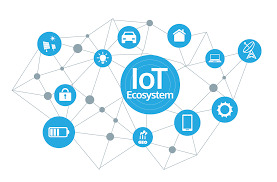
Types of IoT
Networking, communication, and connectivity systems depend on the specific IoT application being deployed. Just as there are many different IoT devices, there are many types of IoT applications depending on their use. Here are some of the more common ones:
• IoT client – intended for everyday use. Examples: home appliances, voice assistants and lighting.
• Business IoT – commonly used in the healthcare and travel industries. Examples: smart pacemakers and monitoring systems.
• Military Matters (IoMT) - Commonly used for the application of IoT technology in the military sector. Examples: surveillance robots and attack-capable objects.
• Industrial Internet of Things (IIoT) - commonly used in industrial applications, such as in manufacturing and the energy sector. Ex: Digital control systems, smart agriculture and big data industries.
• IoT Infrastructure – It is widely used for connectivity in smart cities. Example: equipment sensors and control systems.
Why is IoT important? IoT has enabled the physical world to meet the digital world in collaboration. It provides benefits to organizations by allowing them to work and simplify their work. As IoT grows exponentially year on year, businesses are taking advantage of the incredible business benefits it can deliver. Here are some of the most important benefits of IoT:
• Create new business models and revenue streams
• Improve business decisions and insights based on IoT data.
• To increase productivity and efficiency of business operations
• To improve customer experience
Although global IoT spending has been affected by the economic impact of the COVID-19 pandemic, IDC's analysis shows that it will reach a CAGR of 11.3% over the forecast period 2020-2024.
What are IoT devices?
IoT devices are hardware devices, such as sensors, appliances, devices and other machines that collect and exchange data over the Internet. They are designed for certain applications that can be connected to other IoT devices. For example, an IoT device in your car can detect oncoming traffic and send an instant message to the person you're about to see about an upcoming delay.click amazon market place.
How do IoT devices work?
Different IoT devices have different functions, but they all have similarities in terms of how they work. First, IoT devices are physical objects that see what is happening in the physical world. They have integrated processors, network cards, and hardware, and are often connected to Dynamic Host Configuration Protocol servers. It also requires an IP address to work on the network.
Many IoT devices are programmed and controlled through software. For example, an app on your smartphone to control the lights in your home. Some tools are also built into the web server, eliminating the need for external applications. For example, the light turns on immediately when you enter the room.
1 note
·
View note
Text
ATOMBERG RAISES $86M IN SERIES C ROUND LED BY TEMASEK AND STEADVIEW CAPITAL :-

Atomberg, a digitally native consumer appliances brand, has raised $86 million in funding led by Temasek and Steadview Capital, with participation from Trifecta Capital and existing investors Jungle Ventures and Inflexor Ventures, through a mix of primary and secondary issuances.
The company, founded by IIT Bombay alumni - Manoj Meena and Sibabrata Das - will use the fund infusion to boost manufacturing capabilities, support new product launches, deepen offline presence across key regions. Further, the company aims to expand its offerings including mixer grinders, the ‘Aris’ fan series and smart locks. Additionally, it seeks to enhance R&D capabilities to aid new product launches across various categories.
The secondary share sale, as a part of the deal, has provided an exit to early angel investors of the company. Existing investor A91 Partners has also sold a small part of its stake.
"Our monthly revenue crossed Rs 100 crore in March and currently we are at a $150 million annual revenue run rate," said Das.
Atomberg is planning on expanding into two new categories by the 2023 end or early next year, he said. These include kitchen appliances such as chimneys and cooktops. Its recently launched products - mixer grinder and smart lock - are seeing strong traction in the market, said Das.
"Within one month, we completely sold out our smart lock stock. Mixer grinder is also getting a good early response. We expect mixer grinder to contribute 10% by next financial year," he said.
Atomberg currently has one manufacturing plant with a capacity to produce close to 1 million units a month.
"The BLDC market is 20% of the overall fans market, but is growing at 50% year over year. In next 5 years time it will become 50% of overall market and we want to keep our market leadership intact," said Das.

Atomberg derives 70% of its sales through offline channels and 30% through online sales. Currently, the company's sales largely come from south and west India, contributing 65% to its top line.
"We entered the north and east markets just a year back. On the offline side, we currently have 25,000 counters and we are adding another 2,000 to strengthen our distribution. Offline will remain 70-75% of sales in the long term," said Das.
Atomberg currently has one manufacturing plant with a capacity to produce close to 1 million units a month.
"We are also investing capital to make it more and more automatic," said Das.
2 notes
·
View notes
Text
Beko Marks 3rd Anniversary In The Philippines With Trade Launch, Lays Out Business Development Plans
Beko Philippines is entering a new phase of business in their journey to bring the European brand to a sustainable lifestyle for Filipino customers. In celebration of its third year of operations, Beko announces its goal of being the number one European brand in the Philippine market in the next 5 years.

“We are very happy to be holding this trade launch for our dealers and stakeholders as we share that Beko will be a bigger and better brand in the Philippines in 2023 and beyond,” said Gürhan Günal, Beko’s country director in the Philippines, who also presented the company’s business development plans of EXPAND, GROW, LEAD, CONNECTIVITY and SUSTAINABILITY for the Philippines along with the brand’s hero technologies at the anniversary trade launch at the Grand Ballroom of Marriott Hotel Manila.
This is the heart and reason why this year, Beko will be made available soon in other appliance stores nationwide as it continues to “expand” its distribution to other retail channels.

To further “grow” brand awareness and visibility they also announced the renewal of their brand ambassadorship with Judy Ann Santos-Agoncillo alongside with digital and traditional media investments.
As one of the “leading” manufacturers of home appliances, Beko promotes the Live Like a Pro lifestyle and inspires Filipinos to experience a more convenient way of living through European style product lines. They stated that Beko Pilipinas Corporation is the exclusive distributor of Hitachi Major Domestic Appliances as part of their brand portfolio.
Beko appliances are made smart, relevant and designed to easily support Filipino families. With the HomeWhiz function you can easily “connect” to your Beko appliances with the use of your smartphones.
As part of Beko’s global sustainability effort, Beko Philippines announces its partnership with Plastic Credit Exchange, which serves a global ecosystem of carefully vetted partners that recover, process, and recycle plastic waste with programs that improve livelihood, scale up social impact, and reduce the flow of plastic pollution into nature. The partnership is in line with Extended Producer Responsibility Law, which holds companies responsible for the plastic packaging they use throughout the lifecycle of their products.
Trade launch showcasing hero technologies
As Beko marked its third year in the Philippines, the appliance brand held a grand trade launch for its dealers at the Marriott Hotel Grand Ballroom with the theme “Empowered to Live Like A Pro.”
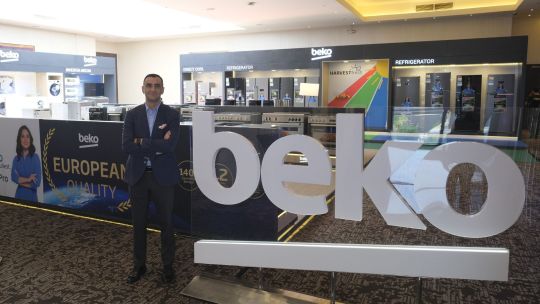
During the whole-day event, guests, including media and dealers, got to experience Beko’s range of appliances. They also got tips from a chef and an interior designer on how to manage their homes like a pro.
Beko Philippines showcased its hero technologies, such as HarvestFresh, ProSmart Inverter Technology, Steam Cure, Hygiene+, AeroPerfect TM and many others. These technologies help you live like a pro. Among the products displayed that day were cookers. The HII64205F2MT is a 60x50cm built-in induction hob with four Cooking Zones and two 2 Flexizone, nine cooking levels and a glass burner plate. Meanwhile, the BBIS14300XCSE 60x60cm. multifunction built-in oven with six cooking functions, including Steam Aid feature for moist and even cooking.

There were also refrigerators, one of the appliances which Beko is famous for. The GNO480E40HFGBPH is a 16.6cf inverter multi-door refrigerator with Neofrost Triple Cooling Technology, HarvestFresh, Prosmart Inverter Compressor, in sleek black glass door finish. Also featured is the Hitachi Refrigerator R-WB640VG0-1 GBK with Vacuum Technology with Platinum Catalyst, Inverter X Dual-fan Cooling with Eco-thermo sensor.
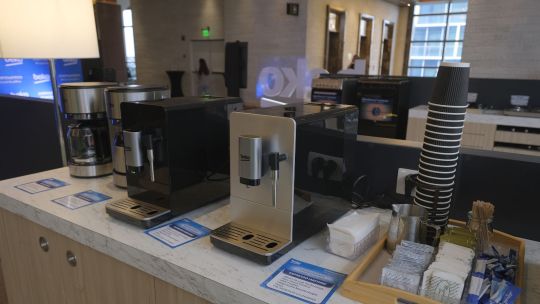
Other appliances include the CEG7302B, a bean-to-cup espresso machine and the BSEOG180/181 2Hp air-conditioner with Go Clean Technology, MicroClean TM Filter, Gold Guard, ZoneFollow, 4D Auto Swing and HomeWhiz.

Beko appliances are available at 1st Megasaver, Abenson, All Home, Anson’s, Appliance Centrum, Asian Home Appliance, Automatic Centre, BHF, Echo Electrical, Fair N Square, Gloria Bazaar, Great World, Hat, J Marketing, Lazada, Magic Appliance, Manhattan Appliance, Mike’s Department Store, NB Marketing, Pricewise, RS David, Our Builders, Robinsons Appliance, Savers, Shopee, SM Appliance, Solidmark, SVC & Plusign, United Motoliance, and Western Appliance.
For more information about Beko in the Philippines, go to http://beko.ph or visit their Facebook page at https://www.facebook.com/bekoph and their Instagram page at https://www.instagram.com/bekoph/.
–
📧 If you wish to send an invite and feature your province/company brand/event; Just ask the author of this vlog, email us at [email protected]
Follow our Social Media Accounts: Facebook Fan Page: https://www.facebook.com/TakeOffPHBlog
Instagram/Twitter: @takeoff_ph
Website: https://takeoffphilippines.com
Subscribe to our YouTube Channel: https://www.youtube.com/c/TakeOffPhilippines
3 notes
·
View notes
Text
Li-Fi conference
*A solution in search of a problem.
27 June 2023, High Tech Campus Eindhoven & Online, The Netherlands
Dear Reader,
We are excited to announce the 3rd edition of the International LiFi Conference, a global event bringing together professionals from various industries to explore the potential of this revolutionary technology. The conference promises to be an exciting opportunity to learn about the latest advancements in LiFi technology and its applications across different sectors.
One of the unique features of LiFi is its potential to transform the way we connect to the internet and share data. The conference will cover a range of topics, including market development, the role of chipset manufacturers, electrical contractors, system integrators, and the telecom/datacom industry, including 5G. In addition, speakers will discuss LiFi applications in healthcare, military, education, industry 4.0/smart manufacturing, automotive, aviation (in-flight entertainment), virtual reality/mixed reality, retail, home, office, museums, and even space. Standardization and security in LiFi technology will also be addressed.
We are honored to have several renowned experts confirmed as keynote speakers, including Harald Haas, Distinguished Professor at the University of Strathclyde, John Joseph, CEO of OptiPulse, Anil Mengi, Corporate Vice President of devolo AG, Shelley Peterson, founder of Wizardwells, Benjamin Azoulay, President and CEO of OLEDCOMM, Markus Werner, Managing Partner of aeroLiFi GmbH, Theo Lazuech, CEO & Founder of LiNA, and many more speakers during the session by Light Communications Alliance.
Don't miss this opportunity to learn about the latest advancements in LiFi technology and its potential applications across various sectors.
Early Bird registration is open until May 10th, 2023. Register now to secure your spot at the conference.
We look forward to seeing you there!
LiFi for the telecom / datacom industry
LiFi, short for Light Fidelity, is an emerging technology that uses light waves to transmit data, rather than radio waves used in Wi-Fi. Unlike Wi-Fi, LiFi uses visible light, infrared or ultraviolet to transmit data, which h...
LiFi in space
LiFi, short for Light Fidelity, is a wireless communication technology that uses visible light instead of radio waves to transmit data. LiFi is based on the principle of Visible Light Communication (VLC), where LED lights are...
System integrators and LiFi
System Integrators play a critical role in helping businesses adopt new technologies and improve their operations. With the emergence of LiFi technology, System Integrators have an exciting opportunity to incorporate this cut...
Revolutionizing Industry 4.0 and Smart Manufacturing with LiFi Technology
As technology advances, so does the need for faster and more reliable data transfer in the manufacturing industry. This is where LiFi, or Light Fidelity, technology comes into play. LiFi uses light waves to transmit data at h...
Applications for Retail, museums and public spaces
Optical Camera Communications (OCC) is a technology that allows for high-speed data transfer through visible light. The technology is popular in various industries, including retail, museums, and other locations where reliabl...
LINCNET: Exploring the Synergy of LiFi and Powerline Communication for Industrial and Medical Applications
The LINCNET project aims to advance LiFi (Light Fidelity) technology as a viable alternative for industry-specific applications. By harnessing the unlicensed optical spectrum, LiFi offers higher data rates in confined areas, ...
6 notes
·
View notes
Text
Digital Twin Market Size 2023-2030: ABB, AVEVA Group plc, Dassault Systemes
Digital Twin Market by Power Source (Battery-Powered, hardwired with battery backup, Hardwired without battery backup), Type (Photoelectric Smoke Detectors, Ionization Smoke Detectors), Service, Distribution Channel, and region (North America, Europe, Asia-Pacific, Middle East, and Africa and South America). The global Digital Twin Market size is 11.12 billion USD in 2022 and is projected to reach a CAGR of 60.9% from 2023-2030.
Click Here For a Free Sample + Related Graphs of the Report at: https://www.delvens.com/get-free-sample/digital-twin-market-trends-forecast-till-2030
Digital twin technology has allowed businesses in end-use industries to generate digital equivalents of objects and systems across the product lifecycle. The potential use cases of digital twin technology have expanded rapidly over the years, anchored in the increasing trend of integration with internet-of-things (IoT) sensors. Coupled with AI and analytics, the capabilities of digital twins are enabling engineers to carry out simulations before a physical product is developed. As a result, digital twins are being deployed by manufacturing companies to shorten time-to-market. Additionally, digital twin technology is also showing its potential in optimizing maintenance costs and timelines, thus has attracted colossal interest among manufacturing stalwarts, notably in discrete manufacturing.
The shift to interconnected environments across industries is driving the demand for digital twin solutions across the world. Massive adoption of IoT is being witnessed, with over 41 billion connected IoT devices expected to be in use by 2030. For the successful implementation and functioning of IoT, increasing the throughput for every part or “thing” is necessary, which is made possible by digital twin technology. Since the behavior and performance of a system over its lifetime depend on its components, the demand for digital twin technology is increasing across the world for system improvement. The emergence of digitalization in manufacturing is driving the global digital twin market. Manufacturing units across the globe are investing in digitalization strategies to increase their operational efficiency, productivity, and accuracy. These digitalization solutions including digital twin are contributing to an increase in manufacturer responsiveness and agility through changing customer demands and market conditions.
On the other hand, there has been a wide implementation of digital technologies like artificial intelligence, IoT, clog, and big data which is increasing across the business units. The market solutions help in the integration of IoT sensors and technologies that help in the virtualization of the physical twin. The connectivity is growing and so are the associated risks like security, data protection, and regulations, alongside compliance.
During the COVID-19 pandemic, the use of digital twin technologies to manage industrial and manufacturing assets increased significantly across production facilities to mitigate the risks associated with the outbreak. Amid the lockdown, the U.S. implemented a National Digital Twin Program, which was expected to leverage the digital twin blueprint of major cities of the U.S. to improve smart city infrastructure and service delivery. The COVID-19 pandemic positively impacted the digital twin market demand for twin technology.
Delvens Industry Expert’s Standpoint
The use of solutions like digital twins is predicted to be fueled by the rapid uptake of 3D printing technology, rising demand for digital twins in the healthcare and pharmaceutical sectors, and the growing tendency for IoT solution adoption across multiple industries. With pre-analysis of the actual product, while it is still in the creation stage, digital twins technology helps to improve physical product design across the full product lifetime. Technology like digital twins can be of huge help to doctors and surgeons in the near future and hence, the market is expected to grow.
Market Portfolio

Key Findings
The enterprise segment is further segmented into Large Enterprises and Small & Medium Enterprises. Small & Medium Enterprises are expected to dominate the market during the forecast period. It is further expected to grow at the highest CAGR from 2023 to 2030.
The industry segment is further segmented into Automotive & Transportation, Energy & Utilities, Infrastructure, Healthcare, Aerospace, Oil & Gas, Telecommunications, Agriculture, Retail, and Other Industries. The automotive & transportation industry is expected to account for the largest share of the digital twin market during the forecast period. The growth can be attributed to the increasing usage of digital twins for designing, simulation, MRO (maintenance, repair, and overhaul), production, and after-service.
The market is also divided into various regions such as North America, Europe, Asia-Pacific, South America, and Middle East and Africa. North America is expected to hold the largest share of the digital twin market throughout the forecast period. North America is a major hub for technological innovations and an early adopter of digital twins and related technologies.
During the COVID-19 pandemic, the use of digital twin technologies to manage industrial and manufacturing assets increased significantly across production facilities to mitigate the risks associated with the outbreak. Amid the lockdown, the U.S. implemented a National Digital Twin Program, which was expected to leverage the digital twin blueprint of major cities of the U.S. to improve smart city infrastructure and service delivery. The COVID-19 pandemic positively impacted the digital twin market demand for twin technology.
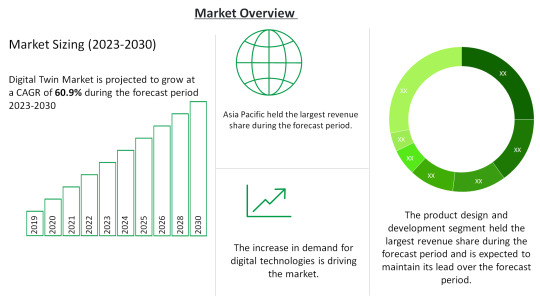
Regional Analysis
North America to Dominate the Market
North America is expected to hold the largest share of the digital twin market throughout the forecast period. North America is a major hub for technological innovations and an early adopter of digital twins and related technologies.
North America has an established ecosystem for digital twin practices and the presence of large automotive & transportation, aerospace, chemical, energy & utilities, and food & beverage companies in the US. These industries are replacing legacy systems with advanced solutions to improve performance efficiency and reduce overall operational costs, resulting in the growth of the digital twin technology market in this region.
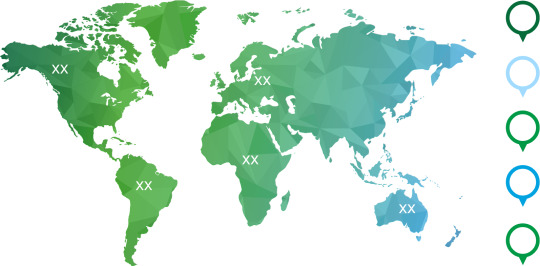
Competitive Landscape
ABB
AVEVA Group plc
Dassault Systemes
General Electric
Hexagon AB
IBM Corporation
SAP
Microsoft
Siemens
ANSYS
PTC
IBM
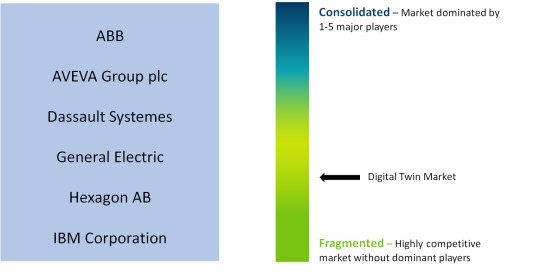
Recent Developments
In April 2022, GE Research (US) and GE Renewable Energy (France), subsidiaries of GE, collaborated and developed a cutting-edge artificial intelligence (AI)/machine learning (ML) technology that has the potential to save the worldwide wind industry billions of dollars in logistical expenses over the next decade. GE’s AI/ML tool uses a digital twin of the wind turbine logistics process to accurately predict and streamline logistics costs. Based on the current industry growth forecasts, AI/ML might enable a 10% decrease in logistics costs, representing a global cost saving to the wind sector of up to USD 2.6 billion annually by 2030.
In March 2022, Microsoft announced a strategic partnership with Newcrest. The mining business of Newcrest would adopt Azure as its preferred cloud provider globally, as well as work on digital twins and a sustainability data model. Both organizations are working together on projects, including the use of digital twins to improve operational performance and developing a high-impact sustainability data model.
Reasons to Acquire
Increase your understanding of the market for identifying the best and most suitable strategies and decisions on the basis of sales or revenue fluctuations in terms of volume and value, distribution chain analysis, market trends, and factors
Gain authentic and granular data access for Digital Twin Market so as to understand the trends and the factors involved in changing market situations
Qualitative and quantitative data utilization to discover arrays of future growth from the market trends of leaders to market visionaries and then recognize the significant areas to compete in the future
In-depth analysis of the changing trends of the market by visualizing the historic and forecast year growth patterns
Direct Purchase of Digital Twin Market Research Report at: https://www.delvens.com/checkout/digital-twin-market-trends-forecast-till-2030
Report Scope
Report FeatureDescriptionsGrowth RateCAGR of 60.9% during the forecasting period, 2023-2030Historical Data2019-2021Forecast Years2023-2030Base Year2022Units ConsideredRevenue in USD million and CAGR from 2023 to 2030Report Segmentationenterprise, platform, application, and region.Report AttributeMarket Revenue Sizing (Global, Regional and Country Level) Company Share Analysis, Market Dynamics, Company ProfilingRegional Level ScopeNorth America, Europe, Asia-Pacific, South America, and Middle East, and AfricaCountry Level ScopeU.S., Japan, Germany, U.K., China, India, Brazil, UAE, and South Africa (50+ Countries Across the Globe)Companies ProfiledABB; AVEVA Group plc; Dassault Systems; General Electric; Hexagon AB; IBM Corp.; SAP.Available CustomizationIn addition to the market data for Digital Twin Market, Delvens offers client-centric reports and customized according to the company’s specific demand and requirement.
TABLE OF CONTENTS
Large Enterprises
Small & Medium Enterprises
Product Design & Development
Predictive Maintenance
Business Optimization
Performance Monitoring
Inventory Management
Other Applications
Automotive & Transportation
Energy & Utilities
Infrastructure
Healthcare
Aerospace
Oil & Gas
Telecommunications
Agriculture
Retail
Other Industries.
Asia Pacific
North America
Europe
South America
Middle East & Africa
ABB
AVEVA Group plc
Dassault Systemes
General Electric
Hexagon AB
IBM Corporation
SAP
About Us:
Delvens is a strategic advisory and consulting company headquartered in New Delhi, India. The company holds expertise in providing syndicated research reports, customized research reports and consulting services. Delvens qualitative and quantitative data is highly utilized by each level from niche to major markets, serving more than 1K prominent companies by assuring to provide the information on country, regional and global business environment. We have a database for more than 45 industries in more than 115+ major countries globally.
Delvens database assists the clients by providing in-depth information in crucial business decisions. Delvens offers significant facts and figures across various industries namely Healthcare, IT & Telecom, Chemicals & Materials, Semiconductor & Electronics, Energy, Pharmaceutical, Consumer Goods & Services, Food & Beverages. Our company provides an exhaustive and comprehensive understanding of the business environment.
Contact Us:
UNIT NO. 2126, TOWER B, 21ST FLOOR ALPHATHUM SECTOR 90 NOIDA 201305, IN +44-20-8638-5055 [email protected] WEBSITE: https://delvens.com/
#Digital Twin Market#Digital Twin#Digital Twin Market Size#Digital Twin Market Share#Semiconductors & Electronics
2 notes
·
View notes
Text
There is a strong need for digital transformation in the construction business
With rising demand for homes and building supplies, the Indian construction industry is anticipated to expand at a 6.2% annual pace in the next years. Construction materials, which make up two-thirds of the overall cost of building, will become more expensive as a result of this rise in material costs, supply chain problems, and inflation. Consumers are unwilling to cut corners when it comes to the quality of the materials used, despite price rises. According to Ashish Aggarwal, Director, SpaceMantra, the building sector is embracing digital technologies like virtual design, VR home tours, cloud-based software, and big data analytics more and more to streamline the real estate process. Mr. Aggarwal discusses his thoughts on the real estate market's current status and how digitization might be a key factor in the future in an exclusive interview with Sanjeev Sinha. India's real estate development industry is booming as a result of the nation's record-high housing demand. How will this impact how construction materials required to develop this infrastructure are consumed and priced? The market dynamics have dramatically changed as of 2023. Since that materials make up around two thirds of the overall cost of building, developers will be forced to raise prices as a result of increased material costs. The supply side shocks, increasing inflation, and the frail global supply chain all contributed to a decline in raw material prices. Customers won't compromise on the quality of the building materials used, therefore a price increase to some level could have a detrimental impact on the fast expanding real estate market. Nowadays, consumers like to choose each component of their ideal home individually. How does it impact online purchasing habits in the digital age?” Allowing clients to hand-pick each component of their dream home helps to give customers the autonomy to decide how their dream home will look in today's increasingly digital world. Yet, doing so can cause the procurement process to go more slowly. Customers and businesses may now choose their preferences from a variety of raw material types, grades, and pricing online in just a few simple steps. With this kind of digital procurement, you may quickly and effectively get the precise materials your project needs. How is the real estate sector using technology to better serve their clients? Due to the increased disruption of the global supply chain, rising competitiveness, and labour shortages, there is an increasingly urgent need for digital transformation in the construction industry. An increasing number of innovative technologies are being incorporated into the building business. Virtual design and visualisation are common in these technologies. The real estate process is made more tech-savvy and results in a smooth experience thanks to virtual reality home tours, cloud-based software, smart contracts, and big data analytics. What are some trends and predictions we can look forward to for the construction sector this year as we usher in a brand-new year? A strong strategy of infrastructure projects in numerous industries is predicted to help the Indian construction industry grow at a 6.2% annual rate from 2023 to 2026. Investment in the construction sector will increase as a result of government initiatives like Atmanirbhar Bharat, which is anticipated to boost domestic industries and micro, small, and medium-sized enterprises (MSMEs), and the Pradhan Mantri Gati Shakti National Master Plan, which aims to drive economic growth through infrastructure development. What lies in store for SpaceMantra going forward in 2023? Building a one-stop eB2B platform is part of SpaceMantra's ambition to organise and unify the extremely dispersed and unorganised construction industry.
We are working hard to strengthen our vendor base by developing close relationships with brands and manufacturers.
This will enable us to provide our product line to customers at lower pricing.
We are also attempting to address the industry's long-standing problems with procurement.
By providing a variety of integrated services that will help them overcome their operational issues, we intend to increase the number of customers we serve in the future.
#ashish aggarwal#ashish aggarwal acube venture#ashish aggarwal indo innovation#ashish aggarwal space mantra
2 notes
·
View notes
Text
This day in history

THIS WEDNESDAY (October 23) at 7PM, I'll be in DECATUR, GEORGIA, presenting my novel THE BEZZLE at EAGLE EYE BOOKS.

#10yrsago Mercilessly pricking the bubbles of AI, Big Data, machine learning https://spectrum.ieee.org/machinelearning-maestro-michael-jordan-on-the-delusions-of-big-data-and-other-huge-engineering-efforts
#10yrsago American businesses devour themselves to enrich the 1% https://www.nakedcapitalism.com/2014/10/goldman-makes-it-official-that-the-stock-market-is-manipulated-buybacks-drive-valuations.html
#10yrsago WATCH: top Scientologists heaping abuse on apostate https://www.youtube.com/watch?v=EG70fhg0wL4
#5yrsago Griefer terrorizes baby by taking over their Nest babycam…again https://www.siliconvalley.com/2019/10/18/the-voice-from-our-nest-camera-threatened-to-steal-our-baby/
#5yrsago It’s dismayingly easy to make an app that turns a smart-speaker into a password-stealing listening device and sneak it past the manufacturer’s security checks https://arstechnica.com/information-technology/2019/10/alexa-and-google-home-abused-to-eavesdrop-and-phish-passwords/
#5yrsago A shrewd guess about the Haunted Mansion’s mysterious Squeaky Door Ghost https://longforgottenhauntedmansion.blogspot.com/2019/10/the-squeaky-door-ghost.html
#5yrsago Rep Katie Porter: an Elizabeth Warren protege and single mom who destroys bumbling, mediocre rich guys in Congressional hearings https://newrepublic.com/article/155268/house-representative-katie-porter-schools-ben-carson-orea-jamie-dimon
#5yrsago Haunted Mansion/Ikea mashup tee https://www.teepublic.com/t-shirt/4196890-haunted-mansion-ikea-instructions
#1yrago The internet's original sin https://pluralistic.net/2023/10/21/the-internets-original-sin/

Tor Books as just published two new, free LITTLE BROTHER stories: VIGILANT, about creepy surveillance in distance education; and SPILL, about oil pipelines and indigenous landback.

12 notes
·
View notes
Text
Deciding on the Perfect Electric Vehicle (EV): A Comprehensive Buying Guide for 2023
The era of electric vehicles (EVs) is upon us, and as the market expands with a wide range of choices, it can be overwhelming to determine which EV is the best fit for your needs. This article aims to provide you with a comprehensive buying guide to help you make an informed decision when choosing an electric car that suits your lifestyle and preferences.

Consider Your Needs: Before diving into the myriad of options available, it is essential to assess your specific requirements. Consider factors such as your daily driving distance, charging infrastructure in your area, budget, desired features, passenger capacity, and cargo space. Understanding your needs will help narrow down your options and streamline your decision-making process.
Driving Range and Battery Capacity: One of the primary concerns for EV buyers is driving range. Consider your daily commuting distance and occasional longer trips to determine the ideal driving range for your needs. Most modern EVs offer a range of over 200 miles, with some high-end models exceeding 300 miles on a single charge. Additionally, pay attention to battery capacity and charging speeds, as they can affect your overall charging experience.
Charging Infrastructure: The availability and accessibility of charging stations are crucial factors to consider when purchasing an EV. Research the charging infrastructure in your area, including public charging stations, home charging options, and the convenience of fast-charging networks. Consider the time it takes to charge the vehicle fully and explore if any additional costs are associated with accessing specific charging networks.

Performance and Handling: Contrary to popular belief, electric vehicles are not solely focused on environmental friendliness—they offer exhilarating performance too. EVs are known for instant torque, providing impressive acceleration and a smooth driving experience. Research the acceleration times and handling characteristics of different models to find an EV that aligns with your driving preferences.
Features and Technology: Modern EVs are equipped with a plethora of advanced features and cutting-edge technology. Look for features such as regenerative braking, advanced driver-assistance systems, infotainment systems, smartphone integration, and over-the-air software updates. Additionally, examine the availability of charging-related applications and smart home integration to enhance your EV ownership experience.

Safety: Safety should always be a top priority when choosing a vehicle. Evaluate the safety ratings of different EV models by referring to organizations such as the National Highway Traffic Safety Administration (NHTSA) and the Insurance Institute for Highway Safety (IIHS). Look for features like advanced collision avoidance systems, lane-keeping assist, adaptive cruise control, and comprehensive airbag systems.
Cost of Ownership: While the initial purchase price of an EV can be higher than that of a traditional gasoline-powered vehicle, remember to factor in the long-term cost savings. EVs have lower operating and maintenance costs due to fewer moving parts and no need for oil changes. Additionally, research available federal and state incentives, tax credits, and potential fuel savings to determine the overall cost of ownership.
See Also: Which Car Should You Buy in 2023?
Brand and Model Reliability: Research the reliability and reputation of different EV brands and models. Look into customer reviews, independent studies, and the manufacturer's warranty offerings. Consider factors such as battery degradation over time and the availability of service centers to ensure a seamless ownership experience.
Conclusion: Choosing the right EV involves careful consideration of your specific needs, driving range requirements, charging infrastructure, performance attributes, features, safety ratings, cost of ownership, and brand reliability. By utilizing this comprehensive buying guide, you can make an informed decision and select an electric vehicle that aligns perfectly with your lifestyle, values, and driving preferences. Embrace the future of transportation with confidence and contribute to a sustainable, emissions-free future.
To explore a comprehensive list of top-rated electric vehicles and read expert reviews, head over to EVSea. They offer valuable insights and detailed analysis to help you find the perfect EV for your needs.
1 note
·
View note
Text
Asia Pacific Self-Storage Market Insights | Growing at 12.61% CAGR to $15.4 Billion
Astute Analytica has released a comprehensive report titled Asia Pacific Self-Storage Market – Global Industry Trends, Share, Size, Growth, Opportunity and Forecast 2024-2032. This report provides an in-depth examination of the industry, including valuable insights into market analysis, competition, and geographical research. It also highlights recent developments in the global industry.
Market Overview and Forecast
Asia Pacific Self-Storage Market was valued at US$ 5.29 billion in 2023 and is projected to hit the market valuation of US$ 15.40 billion by 2032 at a CAGR of 12.61% during the forecast period 2024–2032.
In addition to market positioning, the report offers a thorough analysis of relevant data, key developments, and revenue streams. It outlines the strategies employed by key market players to expand their market presence and strengthen their positions. The report includes detailed information that illustrates the overall market condition.
A Request of this Sample PDF File@- https://www.astuteanalytica.com/request-sample/asia-pacific-self-storage-market
Key Insights
The report emphasizes future trends, market dynamics, market shares, threats, opportunities, and entry barriers. Important analytical data is presented through pie charts, graphs, and tables, providing readers with a clear understanding of the market landscape.
Marketing Channels and Supply Chain
Special attention is given to marketing channels, downstream client surveys, upstream raw materials analysis, and market development trends. The report also includes expert recommendations and crucial information about major chemical suppliers, manufacturers, key consumers, distributors, and dealers, along with their contact details. This information is essential for conducting a detailed market chain analysis.
Geographical Analysis
The report features detailed investigations into the global market across various regions, analyzing over 20 countries that significantly contribute to market development. Key regional markets studied include North America, Europe, Asia Pacific, South America, Africa, the Middle East, and Latin America. This thorough examination aids in identifying regional market opportunities and challenges.
Competitive Analysis
To illustrate the competitive landscape, the report differentiates business attributes and identifies leading market players. It includes the latest trends, company profiles, financial standings, and SWOT analyses of major Asia Pacific Self-Storage market players, providing a comprehensive view of the competitive environment.
Key Players
Mandarin Self Storage
Storefriendly
CubeSmart LP
Quraz Ltd.
OSS Okinawa Self Storage
Locker & Lock Pte Ltd
UD Self Storage
Extra Space Asia Corporate
Storage King Pty Ltd
Other Prominent Players
For Purchase Enquiry: https://www.astuteanalytica.com/industry-report/asia-pacific-self-storage-market
Methodology
The India Smart Card analysis is based on primary and secondary data sources. Primary sources include expert interviews with industry analysts, distributors, and suppliers, while secondary sources encompass statistical data reviews from government websites, press releases, and annual reports. Both data types validate the findings from global market leaders. The report utilizes top-down and bottom-up approaches to analyze estimates for each segment.
Market Segmentation
By End User
Personal
Business
By Country
Japan
China
Hong Kong
Taiwan
Australia
New Zealand
Singapore
Malaysia
Thailand
Rest of Asia Pacific
Download Sample PDF Report@- https://www.astuteanalytica.com/request-sample/asia-pacific-self-storage-market
About Astute Analytica:
Astute Analytica is a global analytics and advisory company that has built a solid reputation in a short period, thanks to the tangible outcomes we have delivered to our clients. We pride ourselves in generating unparalleled, in-depth, and uncannily accurate estimates and projections for our very demanding clients spread across different verticals. We have a long list of satisfied and repeat clients from a wide spectrum including technology, healthcare, chemicals, semiconductors, FMCG, and many more. These happy customers come to us from all across the globe.
They are able to make well-calibrated decisions and leverage highly lucrative opportunities while surmounting the fierce challenges all because we analyse for them the complex business environment, segment-wise existing and emerging possibilities, technology formations, growth estimates, and even the strategic choices available. In short, a complete package. All this is possible because we have a highly qualified, competent, and experienced team of professionals comprising business analysts, economists, consultants, and technology experts. In our list of priorities, you-our patron-come at the top. You can be sure of the best cost-effective, value-added package from us, should you decide to engage with us.
Get in touch with us
Phone number: +18884296757
Email: [email protected]
Visit our website: https://www.astuteanalytica.com/
LinkedIn | Twitter | YouTube | Facebook | Pinterest
0 notes
Text
Future of Automotive Lidar Market: Challenges and Opportunities
The global automotive LiDAR market was valued at USD 504.2 million in 2023 and is projected to grow at a compound annual growth rate (CAGR) of 9.4% from 2024 to 2030. The market's expansion is driven by a combination of factors, including the rising adoption of autonomous and advanced driver assistance systems (ADAS) technologies, increasingly stringent safety regulations, continuous technological advancements, and growing consumer demand for enhanced driving experiences.
A key factor propelling the growth of the automotive LiDAR market is the increasing integration of autonomous and semi-autonomous vehicle technologies. As the automotive industry moves towards self-driving vehicles, LiDAR sensors play a critical role in ensuring accurate perception and mapping of a vehicle’s environment. These sensors are essential for the safety and efficiency of autonomous driving systems, providing high-resolution, real-time data that enables vehicles to detect and respond to obstacles, road signs, pedestrians, and other vehicles. With the development of fully autonomous vehicles, the demand for LiDAR technology is becoming more pronounced.
In addition to autonomous vehicles, the demand for advanced driver assistance systems (ADAS) is another major driver for the automotive LiDAR market. Governments worldwide are implementing stricter safety regulations that require vehicles to be equipped with advanced safety technologies, such as lane-keeping assist, adaptive cruise control, collision detection, and automatic emergency braking. Since LiDAR is a vital component of many ADAS features, the increasing regulatory focus on vehicle safety is boosting the demand for automotive LiDAR systems.
Gather more insights about the market drivers, restrains and growth of the Automotive LiDAR Market
Regional Insights
North America
North America held a significant share of the global automotive LiDAR market in 2023, accounting for 34.9% of the market. This region is marked by substantial investments in autonomous vehicle technology and the strong presence of leading LiDAR manufacturers. The region has become a major hub for innovation, driven by a focus on developing solid-state LiDAR solutions and the integration of LiDAR with other sensing technologies such as cameras, radar, and ultrasonic sensors. These advancements are essential for creating more reliable and cost-effective autonomous driving systems.
In North America, particularly the United States, there is a growing emphasis on partnerships between automotive OEMs (original equipment manufacturers), tech giants, and LiDAR startups, which are pushing the boundaries of innovation and contributing to the market's rapid growth. These collaborations are facilitating the development of new LiDAR technologies, improving sensor performance, and reducing the overall cost of production. Additionally, the testing and deployment of autonomous vehicles are gaining momentum, especially in the U.S., where states like California and Arizona are actively testing autonomous driving systems. This increase in testing and deployment is significantly driving the demand for advanced LiDAR systems, further accelerating market expansion.
U.S.
The U.S. stands at the forefront of LiDAR technology development and adoption. The country is home to a thriving ecosystem of automakers, tech companies, and LiDAR startups, all of which are making substantial investments in autonomous driving research and development (R&D). There is a particular focus on reducing the cost of LiDAR systems while simultaneously enhancing their performance and reliability. The goal is to make LiDAR more affordable and accessible for mainstream use in autonomous and semi-autonomous vehicles.
Moreover, the U.S. automotive LiDAR market is expanding beyond just autonomous vehicles. LiDAR is increasingly being used in smart city infrastructure and advanced driver assistance systems (ADAS) for conventional vehicles. For example, LiDAR sensors are being integrated into vehicles to support safety features like lane-keeping assist, collision avoidance, and adaptive cruise control. The expanding application of LiDAR technology in both autonomous and traditional vehicles is driving further growth in the U.S. market.
Europe
The Europe automotive LiDAR market is shaped by stringent safety regulations and a strong emphasis on reducing carbon emissions. European governments are actively promoting the adoption of electric vehicles (EVs) and autonomous driving technologies to meet environmental targets and improve road safety. As a result, the region has seen increased demand for LiDAR-equipped electric and autonomous vehicles.
Countries like Germany, France, and the UK are at the forefront of research and development (R&D) in the field of automotive LiDAR, particularly with a focus on creating high-resolution, long-range LiDAR systems. These systems are essential for enabling the safe operation of autonomous vehicles in complex driving environments. European automakers are increasingly integrating LiDAR sensors into their premium vehicle models, with a particular focus on luxury and performance vehicles that require advanced safety features.
There is also growing interest in using LiDAR for urban mobility solutions and public transportation. For example, LiDAR technology is being explored for use in autonomous buses, taxis, and other forms of shared transportation, which could revolutionize urban mobility and help reduce traffic congestion and emissions in city centers.
Asia Pacific
The Asia Pacific region, led by countries such as China, Japan, and South Korea, is experiencing rapid growth in the automotive LiDAR market. A key driver of this growth is the push for autonomous vehicle technology, particularly in China, where government support and substantial investments are propelling the market forward. The Chinese government has made autonomous driving a priority and is investing heavily in both technology and infrastructure to support its development.
The region is also witnessing a rise in domestic LiDAR manufacturers, particularly in China, where companies are challenging established Western players. This has led to an increasingly competitive landscape, with Chinese companies developing innovative LiDAR solutions at more affordable price points. This is driving the wider adoption of LiDAR in both premium and budget vehicles across the region.
In addition, there is a growing trend of collaboration between automakers and tech companies in Asia Pacific. These partnerships are fostering innovation in areas such as autonomous driving and AI-powered user interfaces, further enhancing the capabilities of LiDAR systems. The region's diverse market conditions are encouraging the development of scalable LiDAR solutions that can cater to both high-end and mass-market vehicles, making LiDAR more accessible to a wider range of consumers.
Browse through Grand View Research's Automotive & Transportation Industry Research Reports.
• The global automotive digital cockpit market size was valued at USD 24.56 billion in 2024 and is projected to grow at a CAGR of 10.1% from 2025 to 2030.
• The global semi-autonomous vehicle market size demand was valued at 14.22 million units in 2020. The market is expected to expand at a compound annual growth rate (CAGR) of 20.8% from 2021 to 2028.
Key Automotive LiDAR Company Insights
The competitive landscape of the automotive LiDAR market is dynamic and characterized by a blend of established players, innovative startups, and new entrants. As the market matures, companies are increasingly focusing on vertical integration of LiDAR technology to gain more control over the supply chain and differentiate their offerings. Partnerships and strategic collaborations between LiDAR suppliers, automotive OEMs, and tech companies are becoming more common as these organizations work together to bring advanced LiDAR systems to market.
Key Automotive LiDAR Companies
Some of the leading companies in the automotive LiDAR market include:
• Continental AG
• Denso Corporation
• Innoviz Technologies
• LeddarTech Inc.
• KUBOTA Corporation
• Quanergy Solutions, Inc.
• Robert Bosch GmbH
• Teledyne Geospatial
• Valeo
• Velodyne LiDAR, Inc.
Order a free sample PDF of the Automotive LiDAR Market Intelligence Study, published by Grand View Research.
#Automotive Lidar Market#Automotive Lidar Market Analysis#Automotive Lidar Market Report#Automotive Lidar Market Regional Insights
0 notes
Text
Bionic Ear Market Growth, Industry Trends, Manufacturers, and Forecast by 2032
The bionic ear, or cochlear implant, is a groundbreaking device that has transformed the lives of individuals with profound hearing loss. By bypassing damaged parts of the auditory system, this technology enables users to perceive sound directly through electrical stimulation of the auditory nerve. Bionic ears have advanced significantly in recent years, now featuring enhanced sound processing and improved comfort for users. As the technology becomes more sophisticated, it offers new possibilities for individuals seeking to restore or enhance their hearing.
The Bionic Ear Market Size was valued at USD 2.34 billion in 2023 and is expected to reach USD 4.93 billion by 2032 and grow at a CAGR of 8.6% over the forecast period 2024-2032.
Future Scope
The future of bionic ear technology is marked by continuous improvement in sound quality, miniaturization, and wireless integration. Research is focused on improving speech perception in noisy environments, one of the most challenging aspects of auditory processing. Additionally, next-generation bionic ears are expected to incorporate AI algorithms for adaptive hearing, providing personalized sound optimization based on the user’s environment. As these advancements materialize, bionic ears will likely become more accessible to a broader population, enhancing their utility and effectiveness.
Trends
Key trends in the bionic ear market include the integration of smart technology, improved aesthetics, and compatibility with other digital devices. The use of AI and machine learning is enabling smarter, context-sensitive sound processing, while wireless technology allows for seamless connectivity with smartphones and other devices. Furthermore, a focus on aesthetics and comfort is driving the development of smaller, less visible devices, making the technology more appealing to users of all ages.
Applications
Bionic ears are used primarily by individuals with severe-to-profound hearing loss who do not benefit from traditional hearing aids. These devices are life-changing for both children and adults, allowing them to participate more fully in conversations, education, and social interactions. They are also invaluable in workplaces, helping users to hear clearly and communicate effectively. Bionic ears offer enhanced quality of life and open new possibilities for individuals to engage with the world around them.
Key Points
Bionic ears provide hearing through electrical stimulation of the auditory nerve.
Innovations focus on improving speech clarity and sound quality in noisy environments.
Integration with smart technology enables connectivity with smartphones and apps.
Advances in AI support personalized hearing experiences.
Devices offer life-changing benefits for individuals with severe-to-profound hearing loss.
Conclusion
The bionic ear represents a powerful fusion of technology and healthcare, offering profound benefits to individuals with hearing loss. As it continues to evolve, bionic ear technology will not only enhance hearing but also contribute to greater inclusivity, enabling individuals to communicate, engage, and thrive. This remarkable innovation underscores the transformative potential of modern medical devices in restoring quality of life.
#Bionic Ear Market#Bionic Ear Market Size#Bionic Ear Market Share#Bionic Ear Market Growth#Bionic Ear Market Report
0 notes